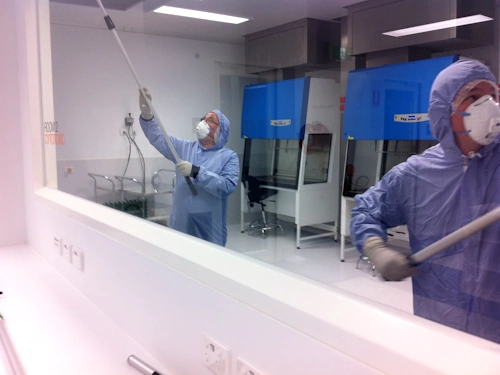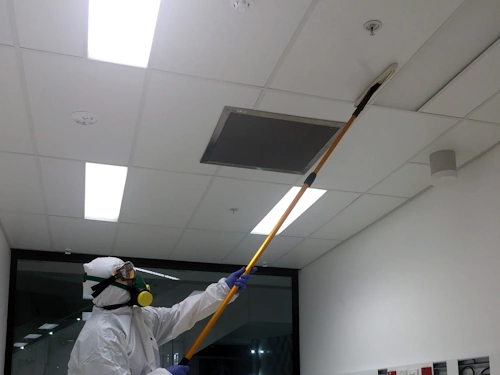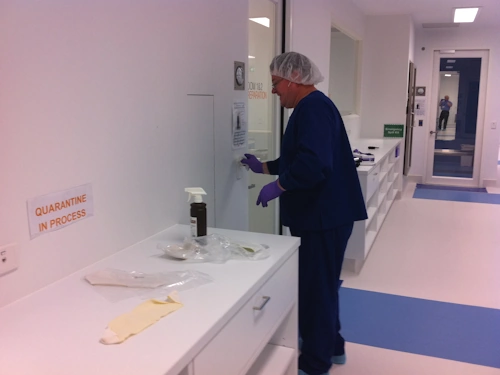
Laboratory cleaning with several cleaners mopping walls and ceilings.

Washing and disinfecting laboratory ceiling with a mop.

Laboratory cleaning involves disinfecting accessible surfaces.
Description
BACS laboratory cleaning services are available nationwide including Sydney, Melbourne, Perth, Canberra, Brisbane, Adelaide, Hobart and Darwin as well as most regional areas. We are experienced in cleaning different types of laboratory including:
- Compounding
- Microbiology
- PC1/PC2/PC3
- Food Grade
- Research
- Clinical - Chemistry, Genetics
- Metallurgy
- Physics
- Scientific
- Wet
A clean laboratory functions more efficiently, produces more reliable results and provides a greater return on investment. Routine facility maintenance including provisions for cleaning is a crucial element of Good Laboratory Practice (GLP). A comprehensive and up-to-date laboratory cleaning programme takes into consideration all laboratory locations to address:
- what elements require cleaning
- where are they located
- how frequently is cleaning required
- how are the elements to be cleaned (age, nature, type and condition of surfaces)
- area function and cleanliness standards
- occupation density and traffic
- contaminant sensitivity (particulates, residue, microbes, etc.)
- infection control requirements (“Hospital Grade Clean”)
Cleaning should be scheduled on a routine, periodic (routine plus additional areas) and project basis to reflect facility policy, quality assurance procedures and local regulations. Finally, an inspection and auditing system needs to be in place to ensure compliance with all cleaning requirements.
Features
- All BACS cleaners pass Australian Federal Police criminal record checks, carry BACS photo ID at all times and are clearly uniformed.
- BACS can follow your existing Scope of Works and Standard Operating Procedures (SOPs) or can help review and create new ones.
- Depending on the intensity and frequency of services requested, BACS laboratory cleaning focuses on removing contaminants from floors, benches (free surfaces and undersides), equipment exteriors, walls, windows and sills (internal), lights and ceilings (additional procedures are available to remove build-up and scuff marks and apply protective coatings on vinyl and hard floors).
- BACS cleaners are trained not to disturb laboratory equipment and benchtop items while cleaning.
- BACS electrical cleaning equipment complies with Australian Standards, is regularly maintained and undergoes routine safety checks.
- HEPA-filtered low-decibel vacuums are used to eliminate dry particles, followed by damp-wiping to remove residue and disinfect as needed.
- Neutral pH detergent and water are used for all non-specific environmental cleaning with designated disinfecting agents applied where necessary.
- BACS cleaners minimise cross-contamination by freshly preparing detergent and disinfectant solutions for each laboratory, using lint-free disposable cloths for cleaning and colour-coded materials and equipment.
- BACS keeps onsite Material Safety Data Sheets (MSDS) for all cleaning chemicals used and follows Work Health and Safety (WHS) guidelines when dealing with any potentially hazardous materials found in laboratories.
Benefits
- Over thirty years of cleanroom cleaning means BACS has experience with a wide range of decontamination methods and can work with you to develop a protocol and schedule to keep your laboratory clean.
- Using professional cleaners ensures that all laboratories are cleaned to the same high standard and laboratory users are free to engage in other activities.
- BACS creates a roster of cleanroom-trained cleaners and their back-ups who undergo further onsite instruction based on your protocols to ensure that properly trained cleaners are always available.
- BACS works with you to establish inspection criteria and a system of review: BACS team leaders oversee and assess the work of cleaners daily; BACS supervisors evaluate work onsite at regular intervals and can submit reports to nominated recipients; BACS management inspects areas randomly, investigates complaints and takes corrective action.